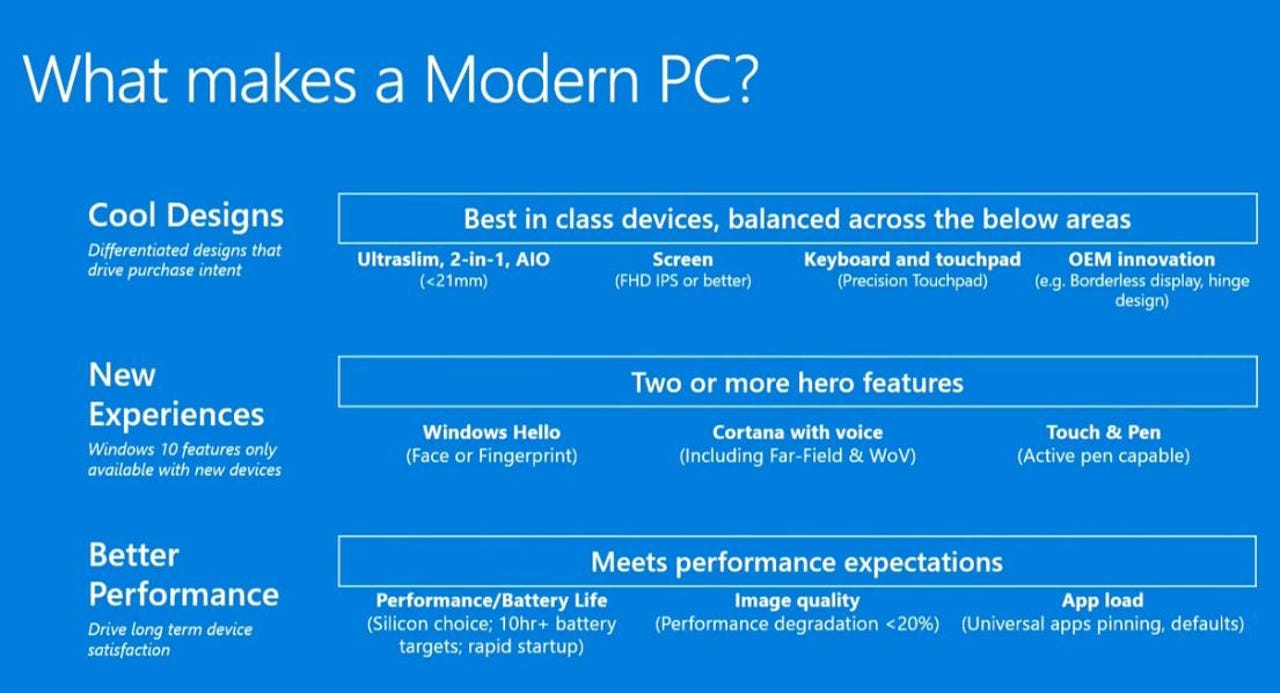Microsoft gives Windows device makers their 2017 marching orders

Microsoft officials have some fairly specific ideas about what they want their Windows-device-making partners to build in calendar 2017.

On the PC front, Microsoft wants its OEMs (original equipment manufacturers) and ODMs (original design manufacturers) to make more Windows 10 detachables, convertibles, and ultraslims. They also are advising their partners to make devices and peripherals that highlight the "hero experiences" of Windows 10 involving Cortana, Windows Hello authentication, and Windows Ink. And another wish-list topper: Microsoft is looking for more Windows 10 PCs that can power mixed-reality peripherals and that are ready for gamers and "media fanatics."
Microsoft officials provided this guidance at the company's WinHEC 2016 conference in December in Shenzhen. Microsoft recently made the video of the "Next Generation of Windows Devices" session from that event.
Microsoft has more than 140 ODM/OEM partners in Shenzhen, according to officials speaking at WinHEC. (ODMs are companies that design and build new devices, which can be branded and sold by other firms; OEMs are companies that build and usually label and sell their own devices.)
Microsoft officials told these vendors that while there are more than 400 million Windows 10 devices in the market (as of September 2016), its goal remains to have "one billion people loving Windows 10 every single day." Microsoft acknowledged last year it's behind its own self-imposed goal of reaching 1 billion by mid-2018, but it's not clear by how much.
The way Microsoft believes it can get to this goal is to encourage partners to make a "few big bets" together with the Redmond company. These bets are familiar ones: The Universal Windows Platform, which enables developers to write apps, drivers, and services that can scale across Microsoft's complete Windows portfolio (PC, tablet, phones, Xbox, embedded devices); a constantly updated version of Windows; and "incredible modern devices" that will replace the more than 600 million Windows devices currently in market that are more than four years old.
Microsoft has identified three hero feature sets for Windows 10 that it is encouraging all its hardware partners to find a way to incorporate in devices: Cortana, Windows Hello authentication, and Windows Ink.
During Holiday 2016 (October to December), Microsoft's emphasis in its marketing campaigns was Windows Ink, according to WinHEC presenters. Between January and March 2017, the focus will be on Windows Hello and security; and from April to June 2017, Cortana will be in the limelight for Microsoft's "dads and grads" campaigns, officials said. Both "Windows switchers" and "Windows loyalists" are the intended audiences for Microsoft's targeted marketing here.
As the company marches towards Holiday 2017, there are a handful of specific new device types where Microsoft is guiding its OEMs and OEMs to invest. And these investment areas indicate the types of Windows 10 devices that Microsoft is expecting and hoping will be in the market later this calendar year.
The five:
PCs for the "modern creator": Two-in-one detachables or convertibles with pens and preferable simultaneous pen and touch capabilities, along with "world-facing and user-facing cameras." Devices that use Cortana in "command and control scenarios" are likely to be big.
Modern peripherals for everyone: Peripherals (keyboards, mice, dials, keychains, wearables, headsets, "communication pucks", etc.) that are Cortana, Hello, and/or Ink-enabled will get the "special logo/branding treatment."
PCs to power mixed reality: Not just desktop PCs, but also two-in-ones, notebooks, and backpack devices that can power the coming, cheaper third-party Windows Holographic headsets should start arriving by holiday in a big way. Those running Windows 10 Creators Update will have discrete CPUs/GPUs; those running later versions of Windows (Redstone 3) will have support for integrated GPUs.
PCs for the gamer and media fanatic: More gaming-class PCs with DX12 GPUs, HDR or WCG displays, and Xbox-compatible peripherals would be well-received, Microsoft officials said. The idea is to bring Xbox and Windows PCs together through both new designs and bundling-focused marketing programs.
IoT devices for verticals: New devices running the various flavors of Windows 10 IoT -- especially those customized for the smart manufacturing, smart retail, and smart home portfolios -- will get love this year. Those optimized to take advantage of other Microsoft products and services, like the Azure IoT Suite, Dynamics 365, and Cortana will get even more love from Microsoft and its customers, company officials told partners.
Yes, I noticed, too, there were no call outs for OEMs/ODMs to make Windows 10 phones. I think the silence here says it all: Microsoft is out of the mobile phone market for the time being and isn't really expecting its partners to take up the slack. Mobile Windows 10 PCs running ARM with built-in cellular connectivity are coming, but maybe not in any kind of volume until calendar 2018, given Microsoft support for Windows on ARM isn't likely until late 2017.
As I've noted before, sources have said that Microsoft is preparing a Spring 2017 hardware launch of its own this year, where new Microsoft-made devices are expected, including possibly a Surface Pro 5 and Surface Book 2. Microsoft also is working on a high-end gaming rig codenamed Project Scorpio for a Fall 2017 release.
It will be interesting to see if Microsoft ends up launching any new Surface-branded products that the company will encourage OEMs and ODMs to emulate (like it has with Surface tablets and its recently launched Surface Studio all-in one) in calendar 2017, as well. And don't forget about that foldable-screen phone patent....
Microsoft is bringing Windows 10 desktop to ARM processors: